|

|
Space shuttle Discovery returns to runway for ride to Smithsonian
April 14, 2012 — Space shuttle Discovery hit the road early Saturday (April 14) to board its jumbo jet ride to the Smithsonian.
Leaving the Kennedy Space Center's 52-story Vehicle Assembly Building at 5:00 a.m. EDT (0900 GMT), Discovery was destined for a steel gantry but not a launch pad. Rolled out before dawn, the retired spacecraft was instead headed for where it last landed from space more than a year ago.
At Kennedy's Shuttle Landing Facility, Discovery is to be hoisted off the ground by the Mate-Demate Device (MDD). The gantry-like metal structure was designed to load orbiters onto the back of NASA's Shuttle Carrier Aircraft (SCA), a modified Boeing 747 used to ferry the winged spacecraft around the nation.
Discovery's final flight plan will take it to Washington D.C. to go on display at the Smithsonian National Air and Space Museum's Steven F. Udvar-Hazy Center. If the weather cooperates, the air- and space-craft combo will depart Florida at just after dawn on Tuesday (April 17), touching down later that same morning at Dulles International Airport.
But first the orbiter needed to be placed atop of the SCA, an activity scheduled to take most of the day.
Round trip
The last time Discovery arrived at Kennedy's landing facility was just before noon EDT (1600 GMT) on March 9, 2011. Completing just over 365 days orbiting the Earth over the course of its 39 missions, Discovery returned from space one final time as the world's most flown spacecraft.
In the year it has taken for it to return to the runway, Discovery has been modified from a space-worthy vehicle to an artifact safe for museum display.
Technicians removed the orbiter's maneuvering thruster feed lines, pyro systems and other hardware that was exposed to hazardous materials during the course of its spaceflight career. NASA also chose to retain some of Discovery's propulsion components, including its three main engines, for possible future reuse.
Otherwise, at the request of the Smithsonian and as the space agency's "vehicle of record," Discovery was left mostly intact. Its main engines were replaced with replicas but its crew compartment was restored with its seats, equipment lockers, food galley and waste collection system (toilet) being reinstalled.
The only major visual component not returned to Discovery but also not kept by NASA was the robotic arm, which was shipping to the Smithsonian separately for its display alongside the orbiter.
Discovery's roll out to the runway was even on the same set of tires on which it last landed from space.
Mating machine
But where Discovery is going, it doesn't need wheels. It needs an elevator.
The Mate-Demate Device (MDD) comprises two 100-foot (30.5-meter) towers and a horizontal structure mounted between the towers. The horizontal unit cantilevers out from the main towers and controls and guides a large lift beam that attaches to the orbiter to raise and lower it.
Three large hoists are used to raise and lower the lift beam. Operating together, the total lifting capacity of the three units is 240,000 pounds (109,000 kilograms or 120 tons).
Discovery tops out at about 167,000 pounds (75,300 kilograms).
Once Discovery is off the ground, the carrier aircraft will be positioned underneath so the orbiter can be lowered atop it. The modified jumbo jet has three protruding attach points that match where Discovery was previously mounted to its external fuel tank for launch.
By the end of the day, the technicians expected to have Discovery "soft-mated" to the SCA. They will complete securing the spacecraft to the aircraft on Sunday (April 15) for its departure two days later.
Photos: collectSPACE.com / Ben Cooper / Robert Z. Pearlman |
|
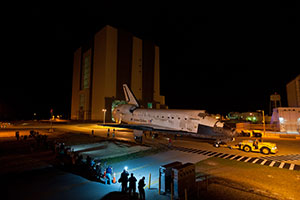
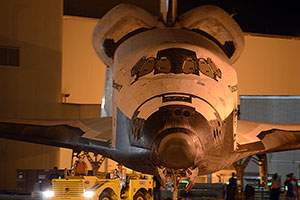
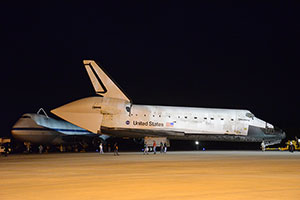
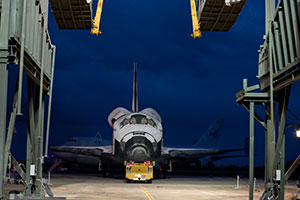
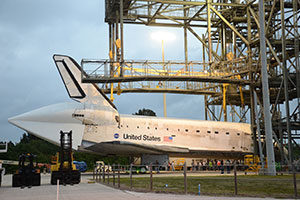 |
|

© 2023 collectSPACE.com All rights reserved.
Questions? E-mail contact@collectspace.com
|
|
